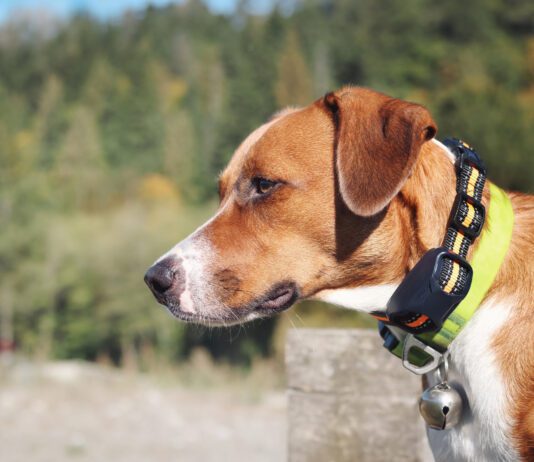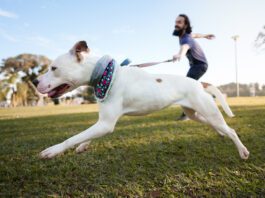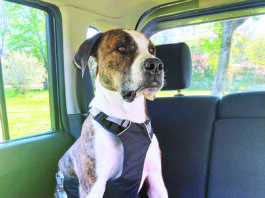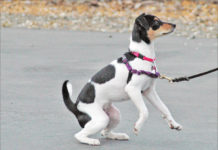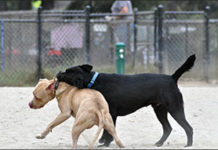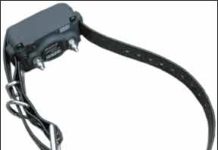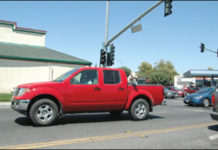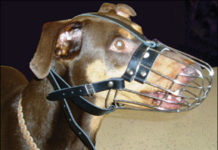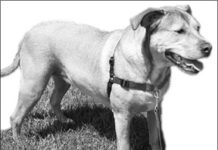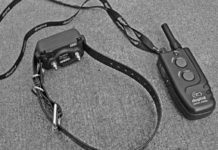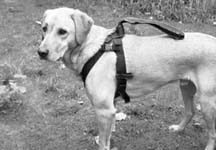The No-Pull Harness Debate
Recently, WDJ received a letter from Christine Zink, DVM, PhD, DACVP, DACVSMR, who was concerned about the photo in WDJ (on the cover, no less!) of a jogger whose dog, running alongside, was wearing a front-clip-type harness. A sports medicine guru and canine athlete enthusiast, Dr. Zink (and others) posit that no-pull harnesses are detrimental to a dog's structure and gait and are especially inappropriate for canine athletes.
When Dog Collars Become Deadly
I was pretty traumatized recently by a phenomenon I had heard about many times but had never before seen: the intense, chaotic, life-or-death struggle that ensues when one dog gets his jaw stuck in another dog's collar. These dogs survived the experience. But since I've been telling my friends about my experience (with all the fervor of the recently converted), I've heard about a number of dogs whose jaws were broken in similar situations
No-Pull Dog Harness Product Review
Once upon a time, a harness was the last thing you wanted to use for a dog who pulled, because they were designed to make pulling comfortable. By distributing pressure evenly across the chest they removed pressure from the throat, where damage could be done to a dog's trachea sometimes even to the point of tracheal collapse. Harnesses are better for the dog from a health perspective, but from a training viewpoint, a standard harness actually encourages pulling. There's a reason sled dogs wear harnesses! Head halters were introduced in the late 1990s as a gentle control tool. While they did, indeed, work well to control a dog's head (and where the head goes, the body follows), some trainers noticed that a significant number of dogs found head halters to be fairly aversive, requiring, in many cases, extensive conditioning to convince the dog to accept them.
Proper Use of No-Pull Harnesses
Some trainers scoff at the use of tools such as control harnesses, claiming that you are simply managing" a problem behavior rather than training the dog. A well-designed control harness
Control Harness Fitting and Use Tips
Here are some trade secrets to getting your control harness to work better for you and your dog. With several of the simpler styles (SENSE-ation, SENSE-ible, Easy Walk) if you can’t get the harness to fit quite right, try putting it on upside down. (Doesn’t work with any of the “two-points-of-contact” harnesses.) If the front strap still slips down, clip your leash to the front-clip ring and the collar ring. This may diminish the effectiveness of the harness a little, but it will keep the front strap up and in place.
Shock Collars and Puppies
Naturally, we regard shock collars as absolutely unnecessary and inappropriate in any training program, but particularly so in training puppies and young dogs. Given the potential for an exceptionally strong fear response during the early fear period – as well as during the secondary fear period – it pains us greatly to see trainers who market their shock collar training even for very young puppies. Of course they mask the aversive nature of shock collars by calling them “electronic” or “e” collars and “electronic fences.”
Buckle Up Your Pup With the Correct Safety Harness!
Those of us who are a bit older remember when seat belts, air bags, and infant car seats did not exist. Today, these safety devices are mandated by laws and most of us would not consider putting ourselves or our children at risk by not using them in our vehicles. So why do many people still risk the lives of another beloved family member - their dog - by allowing their pet to ride unrestrained in their car or truck? A Lab riding shotgun or loose in the bed of a truck, a Shih Tzu on the driver's lap, a German Shepherd hanging his head out of the window, a Pomeranian lying up by the back windshield, a Heinz 57-mix pacing on the back seat we've all seen, or even been guilty of, dangerous animal transport practices.
Training Your Dog to Comfortably Wear a Muzzle
Long thought to be a sign of a bad dog
Leashes, Collars, Harnesses: Best Gear for Positive Training
One bright spring Sunday, my husband and I took a motorcycle trip through Virginia, stopping in the dog-friendly town of Leesburg for lunch. As we ate I watched a steady stream of leashed dogs walk by our restaurant window. Before long I noticed a strange consistency: every single dog was wearing a prong collar. The sun dimmed a little for me, because I cannot imagine a training situation for which I would be willing to use a prong collar - and I certainly wouldn't use one as an everyday dog-walking tool. But the collars appeared to be commonly accepted and used in that community. A roomful of dog trainers will never agree on the best equipment for walking, training, or exercising a dog. If you restrict membership in the room to positive" trainers you'll find more agreement
The Canine Shock Collar Debate
The chasm between those who abhor the electronic/shock collars as an abusive dog training tool and those who support and promote it as an exceptionally effective and humane training tool is so huge it will probably never be bridged. In more moderate positions in the middle of that chasm are those who believe that the collar can be an effective training tool for very limited circumstances in the hands of skilled professionals, and those who prefer not to use them but feel compelled to educate clients who insist on using them on how to use them properly.
A Close Look at Dog Collars
What, exactly, do we like in a collar? To start, we look for top-quality materials – leather that is soft and supple, evenly dyed, neither greasy nor dry; nylon that feels smooth and pliable; and buckles and snaps that open and close easily and securely. Next, we examine the quality of the workmanship. We want to see tight, even stitching, and nylon ends that are smoothly heat-sealed to prevent fraying.
Car Restraints for Dogs
Every day, people load their dogs into cars for trips to the vet or dog park, to run errands, visit friends, or to take day trips. We advocate keeping your dog restrained at all times when he’s traveling with you. The best form of protection is a crate, securely strapped or, better yet, bolted down to keep it from shifting. If your dog’s crate is too big for your car, a doggie seat belt is our recommended alternative.


